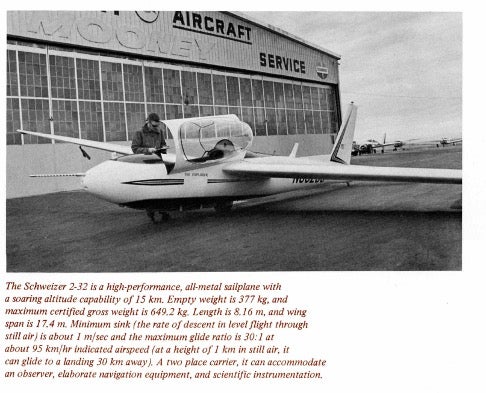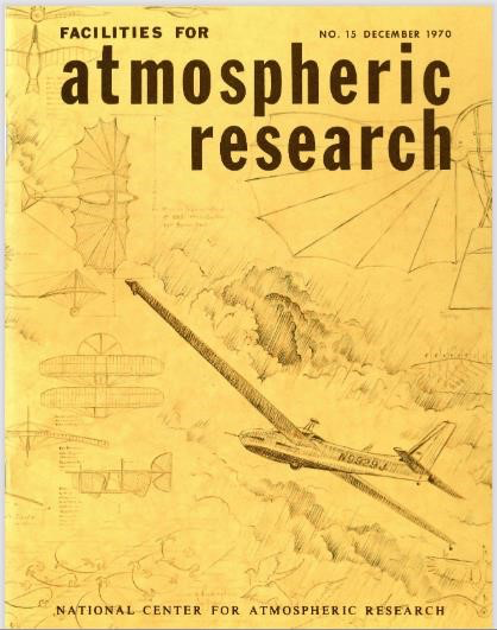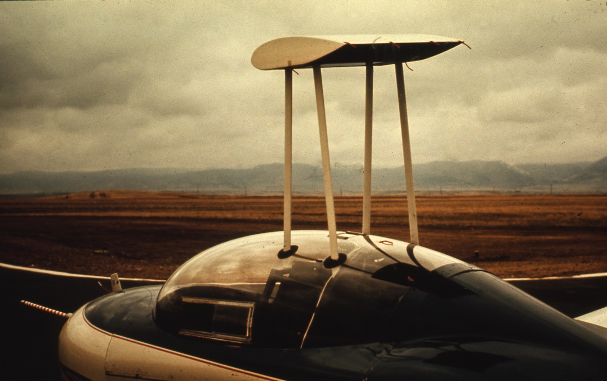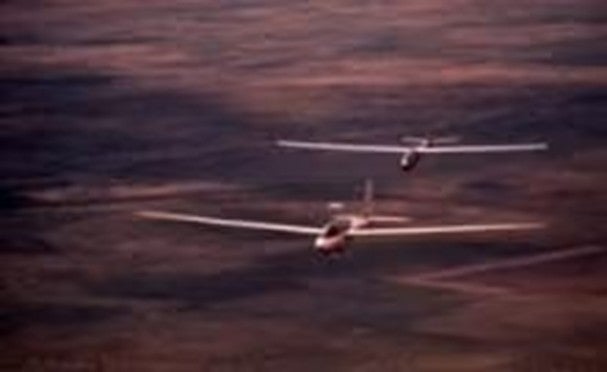Sartor, leader of the Cloud Physics Program at NCAR, along with Kuettner were the driving forces behind using Explorer as an airborne platform for cloud physics research. Toutenhoofd, as pilot and scientist, was the person who made Explorer and its flight viable for research. James (aka Jim) Dye was made assistant leader of the Cloud Physics Group in late 1970 and had responsibility for scientific guidance and instrumentation for Explorer. The period from early 1969 through 1971 was a period of immense activity of adding measurement capability to Explorer and a time of learning how best to fly and conduct operations so that successful research flights could be made. The first studies at NCAR were of CAT in lee waves. See NCAR Facilities for Atmospheric Research, the March 1970 issue: “Research Aircraft in Mountain Lee Wave Study” pp. 10-16 by Doug Lilly.
Beginning in 1970 and 1971 flights were also made in cumulus congestus clouds (CuCg) by releasing the sailplane from a towplane in updrafts below clouds, then using the updraft to spiral up inside a cloud. After 1972 NCAR sailplane flights were almost exclusively made in cumulus congestus clouds to investigate the mechanisms of early development of precipitation. Sartor was also interested in studies of cloud electrification so even in early 1970 there was instrumentation on board to attempt measurements of ambient electric field. The December 1970 issue of Facilities for Atmospheric Research contains the first report pp. 2 – 5 (“The Explorer at NCAR”) on the gift of the sailplane by ERC to NOAA and the intended joint research use and instrumentation of Explorer between NCAR and NOAA. This Facilities report can be found at this link.
A 1970 photograph of Explorer with Vim Toutenhoofd, pilot, performing a pre-flight check
is shown in Fig. 1.
Fig. 1 A duplication of a photograph and caption of the Dec 1970 NCAR Facilities article announcing that Explorer was being operated and flown by the Cloud Physics Program of NCAR for cloud physics research.
This same issue on pp. 7 – 11 also reported on the development of the Cannon Cloud Particle Camera (“Cloud Sampling by Photography”). The cover page of this issue shown below is an artistic illustration of Explorer (N9929J) and of other historical visualizations of attempts at flight.
The first referenced publication on the Explorer being operated by NCAR and some early results were published by Sartor in Physics Today. (Sartor, 1972)
At the same time as Explorer came to NCAR, the National Hail Research Experiment (NHRE) was being organized at NCAR in 1969 to 1971. NHRE had two overarching goals, 1) to conduct a randomized cloud seeding experiment to try to suppress hail based on the Russian hail suppression model, and 2) conduct research to better understand the dynamics and the microphysics of severe storms that produce hail. (Knight and Squires, 1982). From 1972 through 1978 the sailplane effort at NCAR was associated with the research investigations for NHRE. The two photographs of Explorer shown in Fig. 2 and the photograph of sailplane with a cumulus cloud in the background shown on the home page of this website were taken in 1972 during NHRE.
Figure 2: Two photos of the Explorer in 1972 during the National Hail Research Experiment, the top near Boulder and bottom near Ft. Morgan CO. The top photo shows the airfoil for the Cannon Particle Camera above the canopy and the electrostatic disdrometer (an instrument for measuring the size distribution of cloud droplets) at the tip of the boom. Bottom photo shows the Explorer in flight ahead of another sailplane.
- Explorer Participation in the National Hail Research Experiment (NHRE)
- Precipitation Formation via the Ice Process in NE Colorado
- The Discovery by Explorer of Adiabatic Ascent in Clouds of the High Plains
- Discovery of Penetrative Downdrafts
- Observation of a Counter Rotating Vortex Pair in a Cumulonimbus
- Explorer Observations of Silver Iodide Seeding in Cumulus Clouds
- Studies of Initial Cloud Electrification with Explorer
- Electrical/Microphysical Measurements in New Mexico
- Measurements on Explorer of Particle Charge, Size and Shape
- Flight in New Mexico to 40,200 ft with Particle Image and Charge Measurements
- Results from CaPE in Florida in 1991



